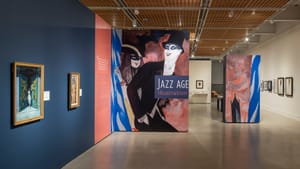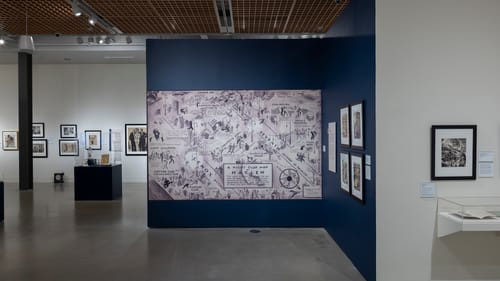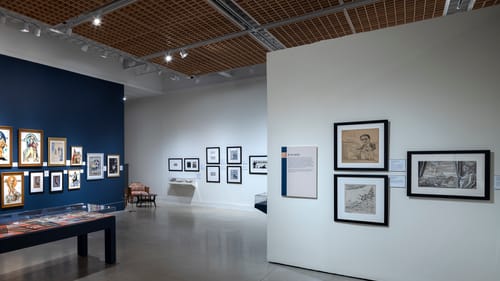Stay in the Loop
BSR publishes on a weekly schedule, with an email newsletter every Wednesday and Thursday morning. There’s no paywall, and subscribing is always free.
Illustrators deserve to be on museum walls
The Delaware Art Museum presents Jazz Age Illustration

Having designated this as their Year of the Illustrator, the Delaware Art Museum has taken a striking deep dive back into the 20th century with Jazz Age Illustration, a stunning exhibition that also chronicles a huge swath of American life and culture.
The museum defines the Jazz Age as the years between 1919 and 1942, an era when the culture surrounding jazz fueled social change. Five years in the making, the exhibition features 197 works by the period’s most prominent illustrators, exploring the visual manifestations of social change during those two decades.
This jewel-box museum is noted (among other things) for its remarkable collection of illustration art, and with only a few exceptions—loans from the Metropolitan Museum, National Portrait Gallery, Free Library of Philadelphia, and a few university and private collections—most works on view come from the museum’s own rich trove. Curator Heather Campbell Coyle has delved deeply to assemble a remarkable array of artworks, books, ephemera, and video.
From ephemera to exhibition
Illustration artworks were seldom made for exhibition. Created as the American publishing industry boomed, they were meant to be reproduced in often-ephemeral publications, so many illustrator’s names are now not well known. But here, the panoply of these masterful artists is properly celebrated. Striking in their ability to bring an era to life, works are divided into 11 easily distinguished and thoughtful viewing categories: the Legacy of Howard Pyle (an early illustration great), Art Deco, Advertising, Modern Style, Modern Love, At the Newsstand, In the Bookshop, Harlem Renaissance, Theater, Sports, and Modern Woman.
The Newsstand section cleverly displays 18 large artworks to mimic the array you might see when buying a magazine. Elsewhere, there are fascinating books and their illustrations, including Rockwell Kent’s designs for an edition of Moby Dick, a book (on view) that actually became more popular because of Kent’s well-known work. Early F. Scott Fitzgerald works were also illustrated like Tender Is the Night, shown here with artwork by Edward Shenton. American painter and muralist Aaron Douglas designed the striking cover for Arthur Huff Fauset’s book For Freedom. (Fauset was an active figure in the Harlem Renaissance.)

Images range from Flash Gordon to those created by the Art Deco great Erté; Campbell Coyle notes that the Art Deco style was transplanted to America via illustrations. And illustrators also recorded the dizzying rise of jazz musicians, so a major section is devoted to the music that gave the exhibition its title. There are vintage films of performers like Josephine Baker, the Nicholas Brothers, and Cab Calloway. Four beautiful watercolors by Jay Jackson (acquired for the exhibition) depict singer/dancer Etta Moten Barnett, a noted star of Porgy and Bess. There is a vitrine displaying period sheet music, and one wall features a huge reproduction of a 1932 map of Harlem (that hotbed of jazz), pointing out famous nightspots and illustrated with clever drawings.
The power of illustration
Illustrations were also often created for advertisements. Then, as now, advertising was not only about the product but also about the viewer who uses that product. Jazz Age Illustration is thus a telling look at social mores (good and not so) and how people lived—or aspired to live. Artists began to focus more strongly on women and African Americans, with an increasing number of publications directed to those demographic groups.
There are illustrations for (and examples of) The Survey, an important African American publication, as well as women’s magazines like Vogue and Ladies Home Journal. And of course, there are illustrations by famous names like Jessie Willcox Smith, Frank Schoonover, John Held Jr., and Norman Rockwell, who created many works for that great American favorite The Saturday Evening Post.
But one of this exhibition’s great strengths (and surprising reveals) is the welcome spotlight that it throws on the artistic range (and popularity) of many artists less familiar to us. The curator’s Jazz Age Illustration checklist (a document listing every work in the exhibition in detail) is 65 pages long, and yet the gallery, packed with almost 200 works, still feels airy and welcoming. And rather than mandating a single path through the exhibition, the creative and well-planned layout allows viewers to experience these works in any order they wish.

In the era before photography dominated the popular media, it was illustration that both showed and shaped the activities and aspirations of Americans, and the museum’s revealing look at that pivotal time is well worth a visit. Jazz Age Illustration is on view through Sunday, January 26, 2025.
Exhibition extras
There are three other things on view that expand on this exhibition. In the museum’s Orientation Hallway is The Record Shop, a large, commissioned site-specific work by Wilmington artist Joanna Booth that was inspired by the sheet music on view. Throughout the neighborhood is a series of outdoor murals called Jazz Around Town. And in a second-floor gallery is the companion exhibition Flapper Philosophy: Modern Women in the Jazz Age, an array of materials from the museum’s Helen Farr Sloan Library & Archives. It celebrates the flapper’s place in 1920s culture and offers a deeper understanding of how the flapper became a defining icon, capturing the essence of an era marked by liberation, innovation, and cultural transformation. Flapper Philosophy can also be seen in an online version.
What, When, Where
Jazz Age Illustration. $6-$18 (kids 6 and under free). Through January 26, 2025, at the Delaware Art Museum, 2301 Kentmere Parkway, Wilmington. (302) 571-9590 or delart.org.
Accessibility
The museum and Copeland Sculpture Garden are wheelchair-accessible, with free parking and a barrier-free entrance. Wheelchairs are available; personal care attendants are admitted free.
Sign up for our newsletter
All of the week's new articles, all in one place. Sign up for the free weekly BSR newsletters, and don't miss a conversation.

 Gail Obenreder
Gail Obenreder